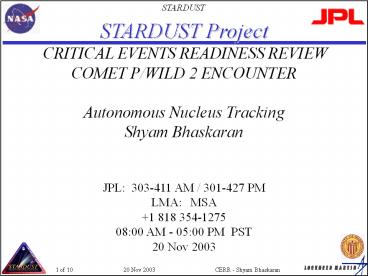1 of 10 - PowerPoint PPT Presentation
Title:
1 of 10
Description:
Delivery of spacecraft using ground based radio/optical navigation ... Due to fortuitous out-of-plane errors being small, roll was never exercised at Annefrank ... – PowerPoint PPT presentation
Number of Views:25
Avg rating:3.0/5.0
Title: 1 of 10
1
STARDUST Project CRITICAL EVENTS READINESS
REVIEW COMET P/WILD 2 ENCOUNTER Autonomous
Nucleus Tracking Shyam Bhaskaran
JPL 303-411 AM / 301-427 PM LMA MSA 1 818
354-1275 0800 AM - 0500 PM PST 20 Nov 2003
2
Nucleus Tracking Rationale
- Delivery of spacecraft using ground based
radio/optical navigation good to about 16 km
crosstrack and 600-1100 km (100-180 sec)
downtrack (1 sigma) at the E - 18 hour point. - Sufficient to maintain spacecraft safety.
- Not sufficient, however, to keep visual lock on
comet for close approach science imaging. In
particular - Crosstrack uncertainty not low enough to
determine flyby plane for the mirror to sweep as
comet goes by. - Downtrack uncertainty too large to determine
mirror angles needed to maintain lock through
closest approach. - Improved knowledge of target relative spacecraft
trajectory in both crosstrack and downtrack
directions is possible using images of the comet
as spacecraft approaches it, but 40 minute round
trip light time prevents ground-in-the-loop
tracking. - Onboard closed loop tracking only option
3
Setup
- Camera FOV 3.5x3.5 deg
- Rotating mirror reflects light path from s/c X
(mirror angle 0 deg) to s/c -Z (mirror angle
90 deg) to s/c -X (mirror angle 180 deg), - From angles 0 to 18 deg, the light path also goes
through a periscope to see around the front
Whipple shields - Periscope incurs additional light attenuation
- Between about 6 and 16 deg, split light path also
results in image doubling
4
Nucleus Tracking Procedure
- Onboard tracking initiated at E-30 minutes.
- Algorithm initialized with nominal values for the
following - Initial target-relative state (position and
velocity), and associated covariance, at E-30
minutes, based on results from ground-based
navigation using E-12 hour opnav - Camera characteristics.
- Predicts for camera pointing for all picture
opportunities based on nominal comet-relative
trajectory. - Images taken at 10-30 second intervals. As each
image is taken, - Image is processed to locate nucleus
center-of-figure (centroiding). - Pixel/line values of observed centroid
differenced with predicted center location to
form residuals. - At E-15 or E-10 min, all images processed with
Kalman filter to get updated state information.
Following this, state update is performed after
every image is processesed. - At E-11 min or E-6 min, latest state information
used to determine s/c roll angle to align s/c X-Z
plane with flyby plane - Inertial pointing predicts are decomposed by ACS
into s/c attitude, mirror angles and rates to
control mirror. - Closed-loop tracking terminated several minutes
past encounter.
5
Nucleus Tracking Verification
- Basic algorithm successfully used for DS1
Borrelly flyby - Stardust specific software tested successfully at
Annefrank encounter last year - Primary differences with Wild 2
- 3000 km vs 300 km flyby distance
- Annefrank images started at mirror angle of 20
deg (so no periscope images were used) vs 0 deg
for Wild 2 - Due to fortuitous out-of-plane errors being
small, roll was never exercised at Annefrank - No dust environment or coma at Annefrank
- Numerous Monte Carlo simulations performed on
unix workstation - Simulates realistic images, ACS gyro drift
errors, state errors - Does not simulate attitude excursions due to dust
impacts - STL testing at Lockheed Martin
- Uses fully integrated software with all s/c
subsystems - Limited number of simulations performed
6
Annefrank Tracking
7
Tracking Imaging Sequence
- Large uncertainty in TOF value
- /- 5 min (3 sigma) if approach opnavs successful
and dynamic correlations hold - /- 9 min (3 sigma) assumes no improvement from
opnavs - 2 image sequences designed to accommodate each of
these cases - At 2 days prior to encounter, the decision would
be made as to which sequence to implement - The nominal sequence will be chosen under the
following conditions - Detection of Wild 2 from spacecraft shows it to
be within reasonable tolerances from the
predicted location - Ephemeris fits using combined ground and opnav
data consistent - Ephemeris fits using different comet dynamic
models show consistent results
8
Tracking Image Sequence (cont.)
- Nominal sequence
- E-30 m to E-5 m 1 frame/30 s
- E-5 m to E5 m 1 frame/10 s
- E5 m to E8 m 1 frame/60 s
- Filter updates started at E-10 m
- Roll maneuver at E-6 m
- Expanded sequence
- E-35 m to E-7 m 1 frame/30 s
- E-7 m to E7 m 1 frame/15 s
- E7 m to E10 m 1 frame/30 s
- Filter updates start at E-18 m
- Roll maneuver at E-11 m
- Number of frames limited by total buffer limit of
72 frames
9
Monte Carlo Simulation Results - Nominal
Overall probability of obtaining images within
2000 km 99.5 Average of successful images
within 2000 km 47
10
Interface Files with Lockheed Martin
11
Issues/Concerns
- Need data through periscope to determine
throughput loss for exposure settings - Planned image through periscope in early December
- Image doubling
- Separation of images (about 20 pixels maximum)
roughly the same as expected size of the nucleus - Separation also about the size of spacecraft
deadband motion - Not expected to cause serious problems
- Currently not simulated, either in Monte Carlo
runs or Lockheed Martin STL runs - Plans to simulate this effect in the very near
future - No open ISAs
- No 1st time events































